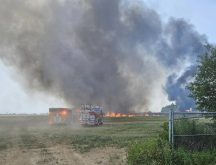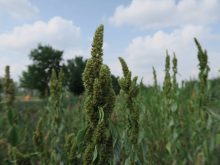Seed control at harvest is not a golden ticket to tackle weeds resistant to glyphosate, fluroxypyr and dicamba, but it’s among a range of solutions needed to stem the tide, says Agriculture and Agri-Food Canada researcher Breanne Tidemann.
“You’re not going to spray your way out of this,” she said about herbicide resistance during her presentation at the Ag in Motion farm show.
Why it matters: Herbicide-resistant weeds are a significant challenge to farms, and mechanical destruction of seeds is an option.
Read Also

Defence investments could benefit agriculture
A bump in Canada’s NATO spending commitments could lead to infrastructure investments that would benefit rural areas
“If you get a new product or new mode of action that works really well, everyone is going to adopt it, the selection pressure is going to go through the roof and we’re going to break that next tool, too. So, continuing to hope, cross our fingers, wishing and praying a new product is going to come out and save us is a little bit naïve, a little wishful thinking.”
However, the ability to mechanically separate weed seed at harvest is part of the solution that looks beyond chemicals.
Development of harvest weed seed control started in the early 2000s in Australia before moving to commercialization with the Harrington Seed Destructor trailer unit.
Field residue management manufacturer Redekop won the Innovations Award for Environmental Sustainability at Ag In Motion for its harvest seed control unit, which destroys more than 95 per cent of unwanted seeds the combine leaves behind.
The battle with herbicide-resistant weeds Down Under has spanned decades, particularly against Italian ryegrass.
“We’re close to 40 years of resistance, building and building,” said Neale Heinrich, Redekop field support and salesperson. “It’s been a battle. All sorts of different processors, chaff carts, burning, all sorts of stuff.”
Chaff collection, chaff trampling, chaff lining, baling behind the combine and burning the straw are all ways to control weed seeds. Some methods remove the chaff, and in turn remove most of the seeds.
Chaff trampling and chaff lining concentrate the material into lines, allowing rot that makes it difficult for weeds to grow.
The Redekop Seed Control Unit destroys seeds that leave the combine through chaff and spreads a refined dust across the field, removing the seed problem without removing the straw.
As long as weeds are harvested, seed destructors have at least a 95 per cent rate of success.
Canadian research with the unit began in 2014, but harvest weed seed control implements for combines have been developed since then and are now commercially available.
While initial research is promising, weeds will likely adapt to mechanical controls over time, says Tidemann.
“Weeds are dirty little buggers that will find some way. They’ll mature more quickly, they’ll drop their seeds earlier, they’ll become more prostrate.
“We’ll see adaptations, I firmly believe that, particularly if we switch whole hog from only herbicides to only relying on this.”
She said control is about redundancy, so the solution is to use a range of techniques.
As far as where the technology goes next, Tidemann said the speed in which it’s already progressed is impressive and manufacturers of weed seed harvest control implements are continually improving the product.
She said she hopes the technology is widely adopted in Canada.
“My understanding from talking to colleagues (in Australia) is 80 to 90 per cent of their farmers are using some form of harvest weed control,” she said.
Unit cost is in the $100,000 range, but Tidemann said it can be installed on one combine to tackle particular weed patches rather than putting one on every combine.














